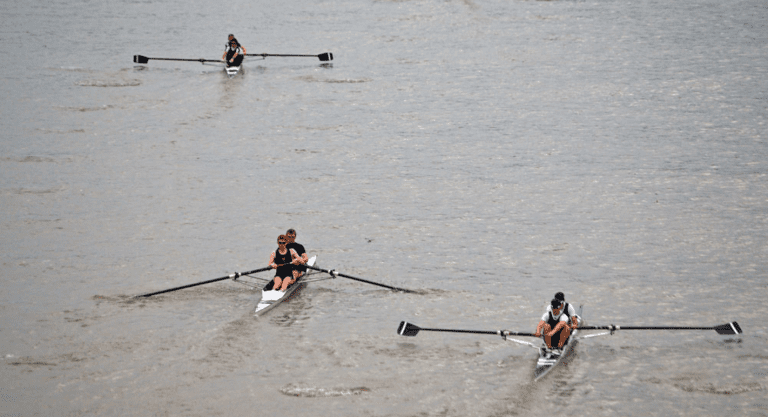Head racing requires totally different tactics from side by side. Mostly because the clock is a different motivator than another crew alongside you. But that’s not the only difference.
5 Reasons Head Racing is the BEST
 Winning Head Races book by Carlo Zezza
Winning Head Races book by Carlo Zezza
- It tests your personal motivation and drive – like no other.
- Steering is critical to success – it can win or lose the race and so adds more “jeopardy”
- Dealing with adverse weather and water conditions rewards skilful boat and oar handling – the strongest don’t always win
- You can race multiple times in a day – some events have divisions so you can race, swap crews and race again.
- Judging your boat speed and optimal rate is tricky and worthy of experimentation
What are your favourite reasons?
Finding the right rating is challenging
I prefer to go off into the race at a rate which I know to be “comfortable” or “achievable”. This allows the crew to get into the rhythm within the first 2 minutes and to warm up. This is important as you often start races colder than you would like because of the waiting around at the start marshalling.
Then take the rate up one every minute until you have got to the point where the boat speed and the technique are no longer giving gains for additional points in rate. This can be judged using a GPS speed meter or by “eye” and “feel”. If the catches get sloppy or the balance goes off and doesn’t recovery fast – that may be a sign that you are at the point of no additional gain.
Here you have a choice – to stay at that rate or to take it down one point. You will quickly find out if the wobbles are due to rate if it settles and stabilises. Beware or going down too much and compromising your boat speed. Also be aware of the wind and water conditions. A head wind will make your “best” rate lower and a tail wind will tend to make it higher. It’s best not to be ruled only by the numbers from your stroke meter – but also to think about the conditions and the crew’s tiredness.
Most crews find they can take the rate and speed up as they approach the finish line of a head race. Challenge yourselves to start your finishing sprint earlier than you think you should. I expect many will find that they can last the distance and also that the increased boat speed is a positive to mental focus and physical effort. However, if your sprint comprises taking the rate up one every ten strokes…. don’t do this when you are 1km from home. You will run out of puff and end up at an unsustainable rating. Choose a different finishing sprint tactic – it could be power alternating with rating, for example. Or a technical call for 10, a power call for 10 and then a rating increase for 10. 1000m is approximately 100 – 130 strokes (depending on experience, boat class, wind and tide).
Rowperfect Resources on Head Racing
So how are you and your crews going to prepare well for head racing?
Here’s our selection of articles which will help you
- Winning Head Races book by Carlo Zezza – the only book on head racing I have found in print.
- The rowing “Sweet Spot” for Head Racing by Sander Roosendaal rowing data expert
- Head race optimal stroke rate discussion on Reddit
- Warming up for a head race from the Rowing Foundation
You can change your mind at any time by clicking the unsubscribe link in the footer of any email you receive from us, or by contacting us at rowperfectuk@gmail.com. We will treat your information with respect. For more information about our privacy practices please visit our website. By clicking below, you agree that we may process your information in accordance with these terms.
We use Mailchimp as our marketing platform. By clicking below to subscribe, you acknowledge that your information will be transferred to Mailchimp for processing. Learn more about Mailchimp’s privacy practices here.







This Post Has One Comment
Head Races are perfect for using Hyndsight CRUZ the only camera and monitor system developed for rowers. It allows you to steer your course and see your lines clearly to not only optimize your performance but to keep you safe from potential collisions.